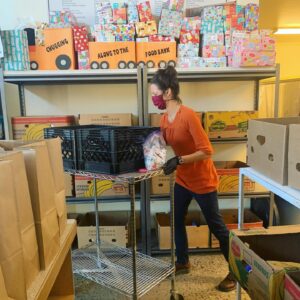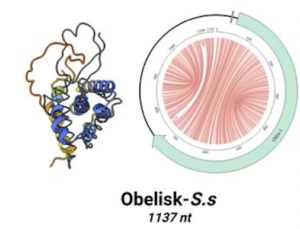
Many American families were already struggling to afford enough food before the COVID-19 pandemic. In the year since the virus hit, millions more are now relying on emergency food assistance to help cover their basic nutritional needs.
In rural and urban communities alike, food banks and hunger relief organizations are straining to keep up with the surging demand. The essential lifelines which these services provide for millions of the country’s most vulnerable people, are stretched to the breaking point.
I bear witness to the realities of poverty and hunger daily, in my role as Operations Coordinator at the North Valley Food Bank in Whitefish, a small town in northwest Montana. Since last Spring, I’ve watched our food aid lines grow continually longer.
Some who access our services are returning users who needed food assistance long before COVID ravaged our economy. But we’re also seeing a rising number of people suddenly experiencing food insecurity for the first time in their lives.
Progress Undone
America’s hunger problem is definitely not new, but the coronavirus-induced economic downturn is making it a lot worse.
A recent Forbes list ranked Feeding America––the national food aid nonprofit––as the second largest charity by revenue in the US in 2020.
According to a Feeding America analysis of COVID-19’s impact, more than 35 million people––including nearly 11 million children––lived in food-insecure households prior to the current public health crisis. The term “food insecurity” is defined as “lack access to enough food for an active, healthy life” for all members.
The nonprofit estimates that at least 50 million people in the country, 17 million of whom are children, likely experienced food insecurity in 2020.
The COVID-related surge in hunger reversed significant strides made in the decade following the Great Recession. Pre-pandemic data showed a hopeful trend: food insecurity rates had hit a 20-year low. All that has changed significantly since COVID.
Leaders in Washington, DC, are at least acknowledging the pressing problem of food insecurity.
In his January 14 “Build Back Better” speech announcing the $1.9 trillion American Rescue Plan, President Joe Biden said, “Millions of Americans never thought they’d be out of work. Many of them never even envisioned the idea, are facing eviction, waiting for hours in their cars to feed their families, as they drive up to a food bank.”
Citing Census Bureau data, Biden noted that one in seven American households, and more than one in five Black and Latino households, do not have enough food to eat. That’s 30 million adults and as many as 12 million children. “It’s wrong, it’s tragic, it’s unnecessary, it’s unacceptable.”
The Biden administration has promised to extend the 15% increase in food stamp benefits initiated by the Trump administration through to the end of 2021 (it was slated to expire in June); to provide financial assistance to restaurants via the FEMA Empowering Essential Deliveries (FEED) Act to help them prepare free meals for hungry people; and to commit an additional $3 billion to ensure food security for mothers of young children.
In the longer term, the Biden administration promises to raise the federal minimum wage from the current $7.25 to $15 per hour.
Given the current state of American politics, all of this relief will likely take months to years before it reaches those who need it. But hunger does not wait, and the lines at the food banks continue to lengthen.
Rural Hunger
Food banks are the frontlines of hunger relief in countless communities.

In communities like Whitefish, and thousands of other rural towns across the country, barriers like limited employment opportunities, low wages, transportation issues, and difficulty accessing far-away resources are common everyday factors that contribute to the hunger problem.
In 2019, our relatively small food pantry served approximately 1,300 community members. That number skyrocketed to 4,445 local residents in 2020––representing a year-over-year increase of 243%.
Unique visits from residents picking up emergency food at our site jumped from 18,184 in 2019 to 30,498 visits in 2020, up 62%.
Those utilizing our services report reduced work hours, job loss, school closures, and COVID-related medical concerns among their primary reasons for seeking food aid.
Rural communities seldom make national news. But big cities do––and the stories of overwhelmed urban food programs are making visible our nation’s widespread, but previously hidden, hunger crisis. Striking images from across the country depict miles-long lines and hours-long waits at food banks in major metropolitan areas, from Pittsburgh to San Antonio to Los Angeles.
Hunger Affects Health
Physically and psychologically, health and hunger are inextricably linked. Inadequate nourishment affects the body on a physiological level––and the prolonged stress of wondering where one’s next meal will come from takes an added emotional toll.
Food insecurity and poor nutrition disproportionately impact many of the same individuals who are at highest risk for serious illness associated with COVID-19, including seniors, patients with chronic conditions, low-income earners, and people of color. The colliding public health and economic crises reveal and exacerbate longstanding health disparities.
Unemployment and poverty unevenly affect Black Americans, putting them at greater risk of food insecurity. Black households bring in significantly lower incomes than White, non-Hispanic households, and are more than twice as likely to experience hunger.
Families with kids who qualify for free or reduced-cost school lunches have been hit especially hard by coronavirus school closures.
In 2019, the National School Lunch Program (NSLP), operated by the US Department of Agriculture (USDA), provided low-cost or free lunches to 29.4 million children daily at a total cost of $14.1 billion. That was about 8% lower than the peak in 2011, when the program was feeding roughly 31.8 million children.
By the third week in March, 2020, during the first wave of COVID-19, school closures resulted in approximately 169.6 million missed breakfasts and lunches served at schools.
Millions of households that depended on school breakfast and lunch programs to make ends meet abruptly lost access to a vital nutrition lifeline. To fill the gap, many school districts have repurposed their would-be dormant kitchens to produce pre-packaged breakfast and lunch kits available to student-families for pickup at schools and other community sites.
Native American communities also experience food insecurity at rates higher than in other populations. As the Feeding America report notes, “this occurrence is driven by above-average unemployment and poverty among Native Americans, resulting from a history of persistent geographic displacement and damaging federal policies.”
The disparities faced by indigenous communities also increases their vulnerability to the coronavirus. Statistically, Native American communities have a greater prevalence of underlying health conditions including respiratory disease and diabetes, and they are more likely than White non-Natives to face limited access to clean water. Barriers to social distancing may also exist in multigenerational communal or crowded living situations. All of this heightens the dual risk of COVID complications and pandemic hunger.
Think Nationally, Act Locally
No single solution will, on its own, ameliorate our food insecurity problem. An effective response requires a mix of national programs addressing broad social inequities, and local initiatives tailored to specific community needs.

One example of a successful federal level anti-hunger initiative is the USDA-funded Farmers to Families Food Box Program. Established in April 2020 as part of the Coronavirus Food Assistance Program, Farmers to Families partners with national and regional distributors to purchase staple food ingredients, package them into family-sized boxes, and transport them to food banks and other direct-service community organizations.
The food boxes contain fresh fruits and vegetables, dairy items, and meat products from American producers of all sizes. The USDA grant dollars that fund the program are awarded to suppliers impacted by business closures in the restaurant, hotel, and food service industries––a win for both food purveyors and families facing food insecurity.
Hunger in modern-day America is rarely a result of famine or crop failure, as was the case in prior centuries. In our time, the problem arises from deeper economic issues, and lopsided distribution.
The supply-and-demand mismatch was clearly evident early on in the pandemic. In some parts of the country, food banks and relief organizations were quite literally running out of food and turning people away. In other regions, farmers were destroying their crops, killing off livestock, or letting fruit and vegetables rot on the ground because the wholesale markets collapsed, transportation was disrupted, or workers had gotten sick at the worst possible times.
The Farmers to Families program was initially slated to run through the end of June 2020. Since then, its popularity has earned it multiple rounds of extended funding and is still ongoing today. USDA reports that it has purchased more than $3.5 billion worth of food to date. The program is currently projected to run through April 2021.
When emergency food resources like the Farmers to Families boxes arrive at regional food banks, it is then up to community-based programs like ours to facilitate their distribution. That can be quite challenging.
It’s wonderful to receive a huge shipment of food large enough to feed an entire community. But it is not easy to determine how to efficiently and equitably share the resources, and to get that food onto the plates of those most in need.
In larger communities, food banks have started using event spaces like football stadiums for massive drive-through food distribution events.
Here in Whitefish, connecting our remote neighbors to food aid remains a top priority. With support from a local philanthropic organization, North Valley Food Bank was able to purchase a box truck shortly after shelter-in-place restrictions first took effect.
Having our own large vehicle enables us to transport larger quantities of food between agencies, and to reach hundreds more recipients through a new off-site mobile pantry program.
We also assist with regular deliveries of Farmers to Families boxes and other food items to aid organizations that serve the nearby Blackfeet Indian Reservation and other remote local communities.
On a weekly basis, we continue to serve residents who have never before accessed our services––or any other emergency food assistance––in their lifetimes. And with no clear end to the pandemic in sight, the demand for emergency food will likely endure into the foreseeable future.
END







